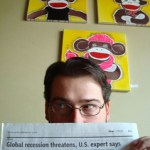
As I'm sure many of you did, I recorded Phil Plait's (twitter, blog) Bad Universe pilot last week, and it was so good that I watched it twice. And then two more times as I tried to figure out why it was so compelling. Why am so interested in picking apart these particular 44 minutes of TV awesomeness? Because at the end of the day, effective science teaching isn't so different from effective science programming, even down to the timing. In an hour of TV, you get about 44 minutes of programming. Likewise, in an hour-long lecture, you can probably only use about 75% of that time, about 44…
Here at The Thoughtful Animal, we are conducting series of seven-question interviews with people who are doing or have done animal research of all kinds - biomedical, behavioral, cognitive, and so forth. Interested in how animal research is conducted, or why animal research is important? Think you might want to do some animal research of your own someday? This is the interview series for you.
Eric M. Johnson (twitter, blog) is pursuing a doctorate in the History and Philosophy of Science focusing on evolutionary biology. He is especially interested in how cooperation and morality were…
The 27th edition of the Carnival of Evolution is being served up at 360 Degree Skeptic. Lots of great posts included as usual, including my two part series on social dynamics in hyena groups: Silver Spoon Hyenas? and Silver Spoon Hyenas: Maternal Social Status Affects Male Reproductive Success.
Also, Andrew has done an exceptional job in curating this month's CoE. If you're hosting a carnival soon, or ever plan to, this is a model to emulate. His commentary is just as riveting as the actual content!
And you do know about (and contribute to, and volunteer to host) all the other carnivals,…
The universe is expanding, and so is the science blogosphere.
Directly on the heels of the announcement last week of the big daddy meta-aggregator to end all aggregators, scienceblogging.org, there are not-one-but-two new science blogging networks that have launched in the last forty-eight hours.
Before I get to the networks, my Scibling (once a scibling, always a scibling) Abel Pharmboy aka David Kroll has moved Terra Sig over to CENtral Science. Go say hello at his new digs.
Yesterday, The Guardian, a legacy media institution, launched a small but impressive science blogging network, that…
Dogs are pretty smart. They can have huge vocabularies, they can infer meaning in the growls of other dogs, and they can effortlessly figure out if other dogs want to play or fight with them. But their intelligence might be limited to the social domain; indeed, while they outperform chimpanzees in social tasks, chimpanzees outperform them in many other tasks. And they might have developed their impressive social skills as merely an accident of natural and artificial selection.
Previous research has shown that dogs can use lots of different forms of human communicative signals to find food,…
Here are my Research Blogging Editor's Selections for this week:
"Distorted perceptions and an altered state of mind: two reasons why psychedelics have always attracted not only fascination, but also controversy for decades." Noah Gray at Nature Blogs has curated a mini-carnival of sorts centering around a new paper called "The neurobiology of psychedelic drugs: implications for the treatment of mood disorders." Included are posts by Mo at Neurophilosophy, the Neuroskeptic, the Neurocritic, and Vaughan of Mind Hacks. (Note: Only Neuroskeptic's and Neurocritic's posts are indexed by Research…
Welcome to the weekly linkfest, August 28 edition.
Science
Brian Switek writes about one of the fastest mammals on earth, the pronghorn, and the complex ecology it lives in. Of Pronghorns and Predators. It's an interesting look into the predator-prey relationships between wolves, coyotes, and pronghorns.
Another great post from Brian, in which he tells us about the mystery of the missing brontosaurus head.
Yet another human falls prey to the illusion of attention. The guys at The Invisible Gorilla explain why there is just no safe way to text while driving.
The dog-human connection in…
Figure 1: A mother hyena with her cubs.
Early developmental experiences can have significant implications for the growth, behavior, survival, and reproductive success of an individual. In many species, one of the most important factors that affects an individual's early development is the maternal environment. However, mothers not only provide an environment for their offspring, but also half of their genes, making it difficult to separate the effects of nature and nurture when investigating developmental outcomes in the offspring. Moreover, because male mammals usually disperse from the…
A fascinating new paper just came out in Nature Communications and I intend to blog it in the usual manner, but I thought I'd try something new first. Check it out:
The Research Question
...According to life history theory, mothers should invest in their offspring if this enhances offspring survival and fitness, and if the fitness benefit to mothers from increased offspring fitness exceeds the cost of their investment. Whether the maternal environment influences the fitness and reproductive value of sons is unknown in most mammals because male mammals usually disperse and, thus, few studies…
Here are my Research Blogging Editor's Selections for this week:
Livia Blackburne asks what something called "visual noise exclusion" has to do with dyslexia. She classifies the post as "intermediate-advanced," but it's a good concise explanation of this complicated research finding.
People have been studying learning in aplysia, the sea hare, for decades. Bjorn Brembs has studied this critter himself for 10 years, but never saw one in the wild, until a recent trip to San Diego. There may be a reason that aplysia can learn.
Christian Jarrett of BPS Research Digest is hunting successful…
Predator-prey interactions are often viewed as evolutionary arms races; while predators improve their hunting behaviors and their ability to sneak up on their prey, the prey improve upon their abilities to detect and escape from their predators. The problem, of course, is that there is a trade-off between maintaining vigilance - the attention necessary to be consistently aware of others in the environment takes quite a bit of physical and mental energy - and doing all the other things that an animal must do, such as finding its own food. As a result of this trade-off, many social species,…
Here's your weekly round-up of fun and fascinating:
To start with, I did a 6-part series on numerical cognition and the development of math skills, here and at Child's Play:
1. The Developmental Origins of Numerical Cognition
2. What is Dyscalculia? How Does It Develop?
3. Developmental Dyscalculia Explained: Strategy, Memory, Attention
4. Numbers on the Brain: Neurobiology of Mathematics
For an evolutionary perspective, there were the two companion pieces this week here:
5. What Are The Origins of Large Number Representation?
6. The Origins of Small Number Representation
Science
From Lucas…
Two important notes for today - the full link round-up, as per usual, will come over the weekend.
First, the meta-aggregator to end all aggregators. Go check out scienceblogging.org - a fantastic tool built by Anton Zuiker, Blogfather Bora, and Dave Munger. It's not perfect, but the whole thing was put together in just the last few days. So go check it out, and leave suggestions and recommendations on the site blog. Read about its origins and philosophy here.
Second, the first edition of the Carnal Carnival is up at A Blog Around The Clock, and the theme is poop. Also, make sure you're…
Earlier this week I wrote about the developmental and evolutionary origins of large number representation. A series of studies in human infants, monkeys, rats, and fish demonstrated that animals and humans spontaneously represent large (>4), abstract, approximate numerosities. Animals, human infants, and human adults, show the same ratio signatures (based on Weber's Law). Adult tamarins are on par with 9-month-old human infants. With age or training, discriminability becomes more precise, and the the critical ratio is reduced a bit. There is good evidence that the large number…
Here are my Research Blogging Editor's Selections for this week!
At BPS Research Digest, Christian Jarrett asks what makes for an effective apology?
Krystal D'Costa of the Urban Ethnographer blog describes an afternoon at a fish market in New York City, and ponders the relationship of smell and memory.
The Neuroskeptic asks "Are you addicted to Starcraft? Do you want to get off Battle.net and on a psychoactive drug?" Is there really a drug that can curb your addiction to video games?
Dirk Hanson of Addiction Inbox discusses the chase for the genes implicated in cocaine addiction.
This post considering the evolutionary origins of numerical cognition, specifically in terms of the approximation of large numbers, is meant as a companion to this week's series on the developmental origins of numerical cognition and developmental dyscalculia, at Child's Play.
What are the origins of number representation in the mind? Are there any innate building blocks that contribute to our understanding of mathematics and number, or must everything be learned?
Number is an important domain of human knowledge. Many decisions in life are based on quantitative evidence, sometimes with life…
There's also a shortage of clean water. Friend of the blog Melissa Rowley is working to fix that.
She writes:
When I see photographs of children in developing countries, I ponder what my life would have been like had I not been adopted. My being here, here and now, and not roaming the streets of Korea or ending up as a sex trafficking tragedy, is more than a coincidence. It's a miracle. The longer I live the more certain I am that I was put on this planet to help those who need compassion, care, and a call to action to help them help themselves.
...the women who are mothers and nurturers…
I will be reposting some dog-related posts from the archives in the coming few weeks as I prepare for the course I'm teaching this semester on dog cognition. Please let me know if you find something inaccurate or unclear.
Domesticated dogs seem to have an uncanny ability to understand human communicative gestures (see here). If you point to something the dog zeroes in on the object or location you're pointing to (whether it's a toy, or food, or to get his in-need-of-a-bath butt off your damn bed and back onto his damn bed). Put another way, if your attention is on something, or if your…
Apparently when something interests you, the best way to figure it out is to smack it really hard, and repeatedly. If you're a cat, at least.
h/t @ferrisjabr
Science and Science Writing
Colin Schultz has committed science blogging! Science bloggers link more often to original research than do mainstream journalists. Not surprising, but good to know there's empirical research.
Hannah Waters of Culturing Science ponders the place of young science writers in the broader science writing ecosystem.
And in response, some good reminders about the business of blogging for n00b bloggers or journos. (via @edyong209)
As usual, another great piece from Bora in which he considers the relative benefits and consequences of being a part of a blogging cooperative…








